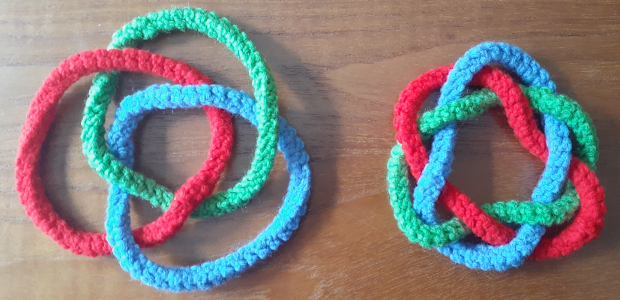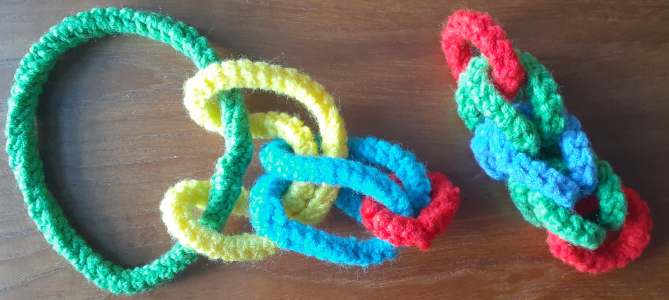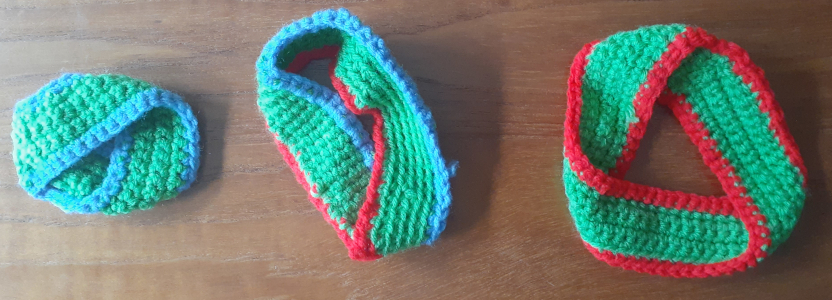4th October 2023, 03:22 pm
3rd October 2023, 11:11 am
The Museum of Mathematics organizes a biannual conference in recreational mathematics called MOVES: Mathematics Of Various Entertaining Subjects. Being a math-recreatinalist myself, I attend all of them. The last one was held in August 2023 and was devoted to the mathematics of Fiber Arts. A few years ago, I wouldn’t have believed I had something to do with the arts. However, in recent years, I started crocheting mathematical objects for my classes, so I not only decided to attend, but also submitted a talk proposal.
The talk proposal was accepted. And, when I finished my slides, I realized that I created too many objects for a 25-minute talk. So, I divided my talk into seven sections and asked the audience to choose. I was lucky that they chose what I was most excited about, but I only had time to cover 4 out of 7 section.
Today I am posting a couple of pictures from my slides that showcase Brunnian links.
A Brunnian link is a set of loops that can’t be separated, but if any one loop is removed, they all fall apart. The most famous example of a Brunnian link is Borromean rings which I already wrote about. In the first picture, the Borromean rings are on the right. They are famous because they are the simplest Brunnian link.
There are two natural ways to generalize Borromean rings. One way is to use the same three loops, but make them twist around each other more. The second way is to increase the number of loops.
The left side of the first picture shows three tangled loops, which are more intertwined than Borromean rings. The crossing number of the link on the left is 12, while the crossing number of the Borromean rings is 6.
The second picture shows two Brunnian links with more than three loops. The left link has four loops, while the right link has five.
Share:





30th September 2023, 11:30 am
* * *
—What’s the best way to get a math tutor?
—An add!
* * *
—Why was the equal sign so humble?
—Because she knew she wasn’t greater than or less than anyone else.
* * *
—Where do mathematicians go on vacation?
—Times Square.
* * *
—Why do cheapskates make good math teachers?
—Because they make every penny count.
* * *
—Why was math class so long?
—The teacher kept going off on a tangent.
* * *
—What did the student say about the calculus equation she couldn’t solve?
—This is derive-ing me crazy!
* * *
—Did you hear about the statistician who drowned crossing a river?
—It was three feet deep, on average.
* * *
—What do organic mathematicians throw into their fireplaces?
—Natural logs.
* * *
—Why is the obtuse triangle always upset?
—It is never right.
* * *
—What is the integral of one divided by a cabin? A log cabin?
—No, houseboat — you forgot the C.
Share:





16th September 2023, 02:53 pm
* * *
—What do you get when a bunch of sheep hang out in a circle?
—Shepherd’s pi.
* * *
—What do you call a metric cookie?
—A gram cracker.
* * *
—What state has the most math teachers?
—Math-achusetts.
* * *
—What does a hungry math teacher like to eat?
—A square meal.
* * *
—What is the mathematician’s favorite season?
—Sum-mer.
* * *
—What adds, subtracts, multiplies, divides, and bumps into light bulbs?
—A moth-ematician.
* * *
—What tools do you use for math?
—Multi-pliers.
* * *
—Why didn’t the quarter roll down the hill with the nickel?
—Because it had more cents!
* * *
—Which snakes are good at math?
—Adders.
* * *
—What is the butterfly’s favorite subject in school?
—Moth-ematics.
Share:





13th September 2023, 12:29 pm
The Ural Math Battle in 2016 had several mafia-themed problems of various difficulty with the same initial setup.
Puzzle Setup. Among 100 residents of Saint-San, m are mafiosi, and the rest are civilians. A commissioner arrived to the town after getting this information. In an attempt to expose the mafia, this commissioner asked each of the residents to name s mafia suspects from among the other 99 residents. The commissioner knows that none of the mafiosi would name other mafiosi, but each civilian would name at least k mafia members. What is the maximum number of mafia members the commissioner can definitively identify after his survey?
- The most difficult case was m = s = 3 and k = 2.
- In the next case, where m = 3 and s = k = 2, the puzzle had a different task: prove that the commissioner can find at least one mafioso.
- In the third case, where m = s = 10 and k = 6, the question was whether the commissioner can find at least three mafiosi.
- In the fourth case, where m = s = 10 and k = 7, the question was whether the commissioner can find all the mafiosi.
- The last case was for younger students with m = 6, s = 10, and k = 6. The question was whether the commissioner can find all the mafiosi.
When I asked ChatGPT to translate the first and the most difficult case of this puzzle from Russian, ChatGPT decided to solve it too. At the end of its ridiculous solution, it concluded that the commissioner could identify all 21 mafiosi out of the given 3. So, if you comment on this blog that the answer to the first case is 21, I will know that you are a bot.
Share:





3rd September 2023, 04:57 pm
I recently saw another puzzle on Facebook, a generalization of a problem from the 2002 Belarus Olympiad. In the problem, there are red and white boxes. Given how Russia and Belarus are filled with propaganda, my first question was whether the Belarusian flag was red and white. But in fact, the official flag is red and green; however, the opposition uses a red and white one. It could either be a coincidence or a sneaky way of protesting. Anyway, here is the problem.
Puzzle. There are two boxes filled with candy. The red box has R candies, and the white box has W candies. Alice and Bob are playing a game where Alice starts, and both players have the same options each turn: Either move one candy from the red box to the white box or take two candies from any box and eat them. The player who can’t move loses. For which values of R and W is each of the following true?
- Alice, following her optimal strategy, wins but might lose if she makes a mistake.
- Alice wins no matter what.
- Bob, following his optimal strategy, wins but might lose if he makes a mistake.
- Bob wins no matter what.
The list of options is weird, but I decided to keep it to emphasize …. Oops, I do not want to spoil it. You can decide for yourself what I wanted to emphasize.
Share:





31st August 2023, 11:32 am
Recently, I decided to stop avoiding puns and childish math jokes. So I am posting a lot of famous jokes I have heard before but never added to my collection.
* * *
—What are ten things you can always count on?
—Your fingers.
* * *
—Why should you never mention the number 288?
—Because it’s two gross.
* * *
—Why did the two 4’s skip lunch?
—They already 8!
* * *
—How do you make one vanish?
—Add a “g” to the beginning.
* * *
—Why was 6 afraid of 7?
—Because 7 8 9.
* * *
—How do deaf mathematicians communicate?
—With sine language.
* * *
—Why don’t math majors throw house parties?
—Because it’s dangerous to drink and derive.
* * *
—What’s the official animal of Pi day?
—The Pi-thon!
* * *
—What do you get when you take the sun and divide its circumference by its diameter?
—Pi in the sky.
* * *
—Who’s the king of the pencil case?
—The ruler.
* * *
—Why was the inchworm angry?
—He had to convert to the metric system.
Share:





20th August 2023, 09:56 am
I’ve been collecting math jokes for many years, but I was avoiding puns, mostly because of my English. Puns are among the most difficult things to master in a language. Here are some punny jokes that I finally understand.
* * *
—Who invented the Round Table?
—Sir Cumference.
* * *
—Why didn’t the hyperbola feel sick?
—It was asymptote-matic.
* * *
—Which triangles are the coldest?
—Ice-sosceles triangles.
* * *
—What’s the one shape you should avoid at all costs?
—A TRAP-ezoid.
* * *
—What do you call more than one L?
—Parallel.
* * *
—What do you call a number that can’t keep still?
—A Roamin’ Numeral.
Share:





18th August 2023, 12:20 pm
I was browsing my analog archives, my high-school notes, and stumbled upon a couple of problems from a math battle we had.
Puzzle. A square is divided into 100 pieces of the same area, in two ways. Prove that you can find 100 points such that each piece in the first division has a point inside, and each piece in the second division also has a point inside.
Puzzle. There is a finite number of points on a plane. All distances between any pairs of points are distinct. Each point is connected to its closest neighboring point. Prove that each point is connected to no more than 5 points.
Share:





17th August 2023, 01:19 pm
Why would I complicate my life by crocheting colored borders onto different strips?
Answer: I wanted to emphasize their borders.
Do you recognize the objects in the picture? The leftmost one is a Möbius strip. I made it by crocheting a long rectangle. Then, instead of connecting the short sides to form a cylinder, I twisted one side 180 degrees before stitching them together. For the other two objects, I made 360 and 540 degree twists, respectively.
I used green yarn for the internal part of the strips. When the twist in the strip is a multiple of 360 degrees, the resulting surface is orientable and has two borders. I used two different colors to emphasize this fact. In other cases, the resulting surface is not orientable and has only one border, so I only used one color for the border.
The point of using extra colors for the borders is to make them more prominent. For example, it is easy to see that the Möbius strip’s border is a circle. The border of the piece in the middle consists of two loops, and the different colors make it obvious that the two borders are linked. The last object has one border, and the color helps you notice that its border is a trefoil knot!
What would happen with the borders if we increase the number of degrees in a twist? Can you figure it out? Are you willing to take up crocheting to solve this puzzle?
Share:







